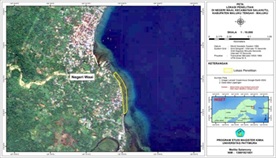Fatty Acid and Amino Acid Profile of Mancadu Clam (Atrina vexillum) in Waai Village
Abstract
Mancadu clam (Atrina Vexillum) is a food source for Maluku coastel communities with high nutritional value and contains various bioactive components, including fatty acids and amino acids. This study analyzed the content of fatty acids and amino acids in mancadu clams (Atrina Vexillum) in Waai village. Fatty acid analysis was carried out through a maceration extraction process with the Shaking Incubator method and transesterification using the microwave. Amino acid analysis was carried out by hydrolysis for 12 hours. The results of the research, the fatty acids of mancadu clams contain 7 fatty acid components, consisting of 2 saturated fatty acids, namely hexadecanoic or methyl palmitate, which is the most significant component (17.61%) and heptadecanoic acid (13.43%). Unsaturated fatty acids are hydrosinnamic acid (15.01%), 5,8,11,14- eicosatetranoic acid/omega-6 fatty acid (7.2%), octadecanoic acid (6.65%), 9-Octadecanoic acid (5.1%) and 8,11-eicosadinoic acid or FUPA (4.68%). The results of amino acid analysis of mancadu clams (Atrina Vexillum) on 18 amino acids obtained 6 types of essential amino acids namely leucine, valine, isoleucine, threonine, methionine and arginine which the largest compound from acid hydrolysis (1150.94 mg/Kg). There are 7 types of nonessential amino acids: glutamic acid, alanine, serine, glycine, aspartic acid, and proline.
Downloads

Copyright (c) 2025 Meilita Salamony, Hanoch Julianus Sohilait, Ivonne Telussa

This work is licensed under a Creative Commons Attribution-NonCommercial-NoDerivatives 4.0 International License.
Authors who publish with this journal agree to the following terms:
- Copyright on any article is retained by the author(s).
- The author grants the journal, the right of first publication with the work simultaneously licensed under a Creative Commons Attribution License that allows others to share the work with an acknowledgment of the work’s authorship and initial publication in this journal.
- Authors are able to enter into separate, additional contractual arrangements for the non-exclusive distribution of the journal’s published version of the work (e.g., post it to an institutional repository or publish it in a book), with an acknowledgment of its initial publication in this journal.
- Authors are permitted and encouraged to post their work online (e.g., in institutional repositories or on their website) prior to and during the submission process, as it can lead to productive exchanges, as well as earlier and greater citation of published work.
- The article and any associated published material is distributed under the Creative Commons Attribution-NonCommercial-NoDerivatives 4.0 International License.





_copy1.png)










